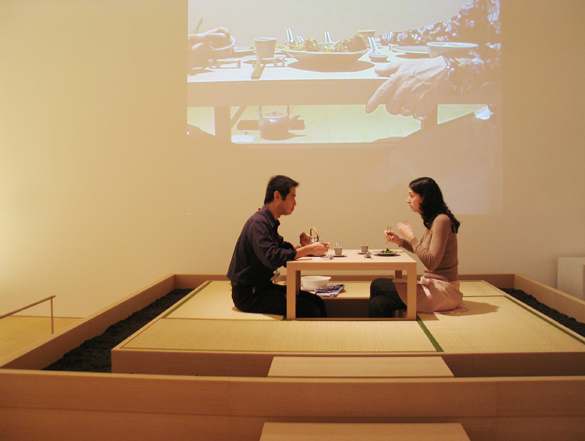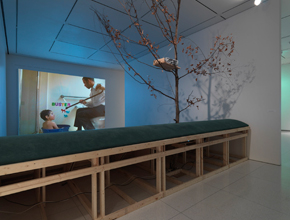An art exhibition where all the pieces involve food -- what's not to love?

By Angela Steinmetz
Head Registrar, Smart Museum of Art
For a museum collections manager or registrar, food in the galleries can pose some big problems. There is a reason most museums strictly ban food and beverages in their galleries, mainly due to the risk it poses to their collections. There is the obvious damage that may happen if food or drink is spilled directly onto artwork, but there is also the increased risk of pests (insects or vermin) that are attracted to food also being attracted to various parts of artwork -- and I'm not talking about appreciation of the art for its visual presence! Certain bugs find wood, paper and textiles very tasty and we try very hard to keep them away from the collections we want to preserve.
So, what happens when your whole exhibition revolves around art made of food?
For Feast, we are taking some extra precautions to make sure our art doesn't invite the wrong kind of audience. For instance, the fresh food used for Alison Knowles's Identical Lunch will be placed in a closed container in the gallery -- not out in the open -- so that it will be less of an attraction to any pests that may come in from the outside, and minimize the risk of elements of the meal accidentally spilling onto other artworks in the gallery.
Ana Prvacki's The Greeting Committee and participatory elements of Mella Jaarsma's I Eat You Eat Me will be presented in our lobby instead of the galleries because they involve guests consuming food. We will also segregate our Bernstein Gallery from the rest of the galleries at certain times in order to present Tom Marioni's The Act of Drinking Beer With Friends is the Highest Form of Art. There will be several events over the run of the show where the gallery will become an active bar with patrons taking part in the work by drinking beer.
One of the most challenging pieces in terms of keeping the pests out will be Lee Mingwei's The Dining Project. The artist will be serving meals to a select few individuals during the run of the exhibition in the gallery space. We don't want any crumbs or left-overs to attract pests, so we will be performing thorough cleanings of the area after the meals take place, and will be continuously monitoring the space with small bug traps so that we can address any issues that may arise.
 The Dining Project also incorporates 270 pounds of dried black beans into its large platform -- yes that's a lot of beans! Before the beans even enter the galleries we will need to make sure they don't contain any bugs. This can be done by "cooking" the dry beans at a low temperature in an oven, or alternatively the bugs can be killed by freezing and thawing the beans over several weeks. The freezing trick is often used by museum professionals to control bug infestations (it is usually less damaging to objects than heat), but the Smart has utilized the faster heating method for contemporary projects where the materials end up being discarded after the exhibition. The full-sized tree used in Guy Ben-Ner's Wild Boy, shown in the Smart's presentation of Adaptation in 2008, was heat treated in an industrial wood kiln in order to make sure that it did not contain any art-eating bugs, and was also safe for the public to touch.
The Dining Project also incorporates 270 pounds of dried black beans into its large platform -- yes that's a lot of beans! Before the beans even enter the galleries we will need to make sure they don't contain any bugs. This can be done by "cooking" the dry beans at a low temperature in an oven, or alternatively the bugs can be killed by freezing and thawing the beans over several weeks. The freezing trick is often used by museum professionals to control bug infestations (it is usually less damaging to objects than heat), but the Smart has utilized the faster heating method for contemporary projects where the materials end up being discarded after the exhibition. The full-sized tree used in Guy Ben-Ner's Wild Boy, shown in the Smart's presentation of Adaptation in 2008, was heat treated in an industrial wood kiln in order to make sure that it did not contain any art-eating bugs, and was also safe for the public to touch. The museum is taking extra precautions for the artwork that will be presented in Feast, but museums all over battle with pests daily in their work to preserve art and artifacts for future generations. Most museums practice some form of Integrated Pest Management (IPM) in order to safeguard their collections -- ranging from pest monitoring and special cleaning schedules, to the ever-present no food and drink policy.
So the next time you want to bring your coffee into the museum but find yourself staring at a "no food and drink" sign, don't be disappointed. Take some pride in knowing that you are helping to protect the museum's collections from damaging pests instead!
Top: Lee Mingwei, The Dining Project, 1998, documentary photo of performance at the Whitney Museum of Art. Courtesy of the artist and Lombard-Fried Projects.
Above: The tree used for the Smart's 2008 presentation of Guy Ben-Ner's Wild Boy was heat treated to make sure it was pest-free.